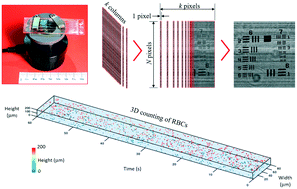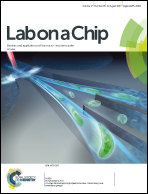Holographic microscope slide in a spatio-temporal imaging modality for reliable 3D cell counting†
Abstract
In the current trend of miniaturization and simplification of imaging flow cytometry, Lab-on-a-Chip (LoC) microfluidic devices represent an innovative and cost-effective solution. In this framework, we propose for the first time a novel platform based on the compactness of a holographic microscope slide (HMS) in combination with the new computational features of space-time digital holography (STDH) that uses a 1D linear sensor array (LSA) instead of 2D CCD or CMOS cameras to respond to real diagnostic needs. In this LoC platform, computational methods, holography, and microfluidics are intertwined in order to provide an imaging system with a reduced amount of optical components and capability to achieve reliable cell counting even in the absence of very accurate flow control. STDH exploits the sample motion into the microfluidic channel to obtain an unlimited field-of-view along the flow direction, independent of the magnification factor. Furthermore, numerical refocusing typical of a holographic modality allows imaging and visualization of the entire volume of the channel, thus avoiding loss of information due to the limited depth of focus of standard microscopes. Consequently, we believe that this platform could open new perspectives for enhancing the throughput by 3D volumetric imaging.



 Please wait while we load your content...
Please wait while we load your content...